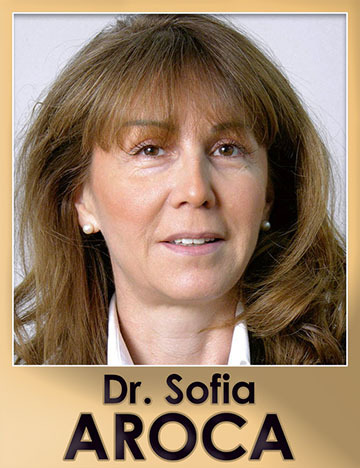

Dr. Sophia Aroca has been practicing Periodontology and Implantology exclusively since 1996.
Parallel to her private practice, she never stopped doing clinical research, teaching activities and lecturing around the world.
She is Visiting Professor in the Department of Periodontology at Bern University , Switzerland .
Dr. Aroca has been awarded a PhD degree at the University of Szeged, Hungary in 2011 and was also awarded of an honorary professorship at the same University in 2012.
Her dream came true in 2018 where she co-created a Continuing Education and Clinical Research Center in Paris, France.
In 2019, Dr. Aroca was elected to the Osteology expert council.
Main Podium Lecture
Multiple Coronally advanced flap vs Modified coronally advanced tunnel technique: A decision making process for treatment of multiple recession type defects
For recession coverage, the most studied and cited surgical technique in the literature is the coronally advanced flap with a connective tissue graft (CAF + CTG) as the meta-analyses from several systematic reviews showed the greatest potential for recession reduction and complete root coverage. Therefore, the CAF+CTG being the “gold standard” is still the approach of choice so far. However, we can take issue with this statement when we face multiple recessions because of the increased biological and anatomical complexity.
Several surgical techniques for the treatment of multiples recession type defects have been evaluated in different type of studies ( RCT,Meta-analyses, systematic reviews) among them the Multiple coronally advanced flap (MCAF) and Multiple coronally advanced Tunnel (MCAT). These two techniques showed their capacity to reach the previous objective requirement (i.e. CRC) as long as they are adapted to thoroughly evaluated clinical situation. Therefore, the treatment of multiple recession with a single surgical technique is a more complex task, since the diversity of anatomical condition in any single tooth , the wider avascular areas, and the position of the teeth.
Various elements must be taken into account at the initial evaluation. So far, there is no a clear distinction in which of them are major or minor determinants and how they influence the surgical choice and the decision making process is still a hard task for the surgeon.
The aim of this presentation is to share a decisional making process based on literature and clinical experience to identify the most indicated surgical procedure for the treatment of multiple recession type defects in any particular anatomic conditions.
Learning objectives:
• To understand the biological and anatomical bases of the two most used surgical techniques for multiple recession coverage.
• To clearly differentiate the major determinants for the right choice of the surgical procedure.
• To learn how to apply the decisional making process to achieve predictable results in the most complex clinical cases.
Hands-on Workshop with Dr. Massimo de Sanctis (Wednesday, October 2, 2024 | 8:00am - 5:00pm)
Periodontal Plastic Surgery
• Periodontal plastic surgical procedures aiming to treat multiple recession defects have been extensively described in the literature. Most of them can be combined with CTG or with soft tissue substitutes in order to increase the marginal gingiva thickness which in turn ensures the long term stability.
• Nevertheless, the surgical techniques used are very technical sensitive and need a deep knowledge on behalf of the clinician in order to obtain predictable results.
• The course will focus on presenting step by step of the tunnel technique and a comprehensive philosophy of surgical risk factors which need to take into account to optimize the clinical outcomes. Clinical cases and surgical techniques using connective tissue grafts and a new resorbable matrix will be demonstrated.